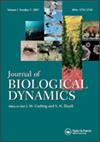空间动力学对环境传播疾病行为的影响
IF 1.8
4区 数学
Q3 ECOLOGY
引用次数: 2
摘要
了解病原体在环境中的传播对于更全面地了解疾病动态至关重要。然而,许多疾病动力学的数学模型忽略了空间效应。我们试图通过扩展空间数学模型以包括空间变化来扩展关于裸鼻袋熊(Vombatus ursinus)和疥疮管理(病因Sarcoptes scabiei)之间相互作用的知识。发现疥螨以时空行波的形式在我们的模拟区域内移动,留下了局部宿主灭绝的小块,与实地观测结果一致。感染传播的速度也与实地研究相当。我们的模型预测,当空间模型预测灭绝时,空间动力学的包含导致受影响袋熊种群的生存和恢复。总的来说,这项研究证明了环境传播的疥螨如何导致行波动力学,并且包含空间变异揭示了比空间建模方法更具弹性的宿主种群。本文章由计算机程序翻译,如有差异,请以英文原文为准。
The effect of spatial dynamics on the behaviour of an environmentally transmitted disease
Understanding the spread of pathogens through the environment is critical to a fuller comprehension of disease dynamics. However, many mathematical models of disease dynamics ignore spatial effects. We seek to expand knowledge around the interaction between the bare-nosed wombat (Vombatus ursinus) and sarcoptic mange (etiologic agent Sarcoptes scabiei), by extending an aspatial mathematical model to include spatial variation. S. scabiei was found to move through our modelled region as a spatio-temporal travelling wave, leaving behind pockets of localized host extinction, consistent with field observations. The speed of infection spread was also comparable with field research. Our model predicts that the inclusion of spatial dynamics leads to the survival and recovery of affected wombat populations when an aspatial model predicts extinction. Collectively, this research demonstrates how environmentally transmitted S. scabiei can result in travelling wave dynamics, and that inclusion of spatial variation reveals a more resilient host population than aspatial modelling approaches.
求助全文
通过发布文献求助,成功后即可免费获取论文全文。
去求助
来源期刊

Journal of Biological Dynamics
ECOLOGY-MATHEMATICAL & COMPUTATIONAL BIOLOGY
CiteScore
4.90
自引率
3.60%
发文量
28
审稿时长
33 weeks
期刊介绍:
Journal of Biological Dynamics, an open access journal, publishes state of the art papers dealing with the analysis of dynamic models that arise from biological processes. The Journal focuses on dynamic phenomena at scales ranging from the level of individual organisms to that of populations, communities, and ecosystems in the fields of ecology and evolutionary biology, population dynamics, epidemiology, immunology, neuroscience, environmental science, and animal behavior. Papers in other areas are acceptable at the editors’ discretion. In addition to papers that analyze original mathematical models and develop new theories and analytic methods, the Journal welcomes papers that connect mathematical modeling and analysis to experimental and observational data. The Journal also publishes short notes, expository and review articles, book reviews and a section on open problems.
 求助内容:
求助内容: 应助结果提醒方式:
应助结果提醒方式:


